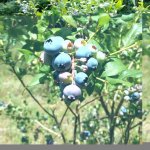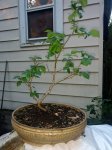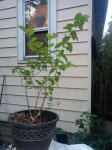In case you haven't figured it out or heard before, I am minority partner in a farm with 3 acres of blueberries, and the only one in the bunch who knows which end of the bush gets planted in the ground. We bought the farm autumn 2015, so I only have 2 commercial harvests under my belt. 3 acres can produce 12,000 to 24,000 pounds of berries without much effort, more if care is above average. Spring 2017 was my first foray into blueberry bonsai. So I got some, but not much hands on experience, from commercial and hobby side of things.
The typical blueberry cycle for a single shoot is:
year 1 - New unbranched shoots emerge from roots. This can be almost anytime during the growing season. It grows first season without branching. Typically, over winter apical bud will die, next year's extension will be from buds a little bit back from the tip. For a mature highbush BB, this single shoot can reach 6 feet (2 meters) in one 4 month growing season, without branching. It almost reminds me of a bamboo shoot, except it has rounder leaves and grows slower than bamboo.
year 2 - usually get two or more buds to send out or up secondary branches. Again, terminal buds die over winter. Most of buds will be near top of shoot, but not always, branches can occur anywhere along the shoot.
year 3 - branches develop on 2nd year branches pattern is as before, but within 30 days after fruit is ripe on older branches, the flower buds tend to begin to form. For me, 'Bluecrop' cultivar normally will ripen fruit before Aug 1, by August 15 to Sept 1 you can begin to see the larger, rounder terminal buds that will become the flowers. These larger, rounder terminal buds will survive the winter, and in spring will open as flowers. There tends to be 4 to 16 or so flowers on each stem that emerges from the flower buds. Average is 8 to 12 on a bush in the ground. These flower buds won't open until spring of year 4.
Year 4 thru year 10 - each year adds another level of branching. Note, frequently dormant buds along older stems will sprout, keep an eye on these, as these may take over nutrient supplies to the branch at expense of the more highly branched portion of the stems. Spring the flower buds will expand, and flowers will open about the same time early blooming apples start. Leaves will begin to expand as flowers are opening. Most northern highbush blueberries are self - fertile, a single plant will set a reasonable crop of fruit. Northern lowbush, and Rabbit Eye blueberries usually require a different cultivar to be present to pollinate. For these have at least two different cultivars on your bench. Southern highbush, from what little I have read, some are self fertile some require cross pollination. Solitary bees and bumble bees are the best pollinators,. Honeybees can pollinate blueberries, but they have to visit the same flower several times before they get the job done. Honeybees are too large to slip into the flower the way solitary bees do, and not heavy enough to vibrate the whole flower the way bumblebees do. Commercial growers actually purchase bumble bee boxes if they are only doing blueberries, rather than mess with honeybees. If they have other tree fruit besides blueberries, they usually will use honeybees, even though they are not as effective. Years 4 through 10 this shoot will be most productive producing fruit. After 10 years fruit size and quantity start declining, most commercial operations will prune out ''canes'' older than 10 years to encourage new shoots in order to maximize the number of shoots in the 4 -10 year age range
year 11 and beyond - here the shoot is ''past its prime'', and care must be taken to keep the root system from abandoning this branch. Dormant buds will keep sprouting on old wood and try to replace ramified branches with less branched younger branches. If you stay on top of this pattern tendency to revert to more juvenal growth, you can keep the branch growing indefinitely. But you might also consider that at some point, you will just have to replace an old shoot with a younger one. View the blueberry as a ''temporary'' bonsai, which will very couple decades have to replace the main trunk with a new one.
so below are some of my blueberries, In the field, 'Bluecrop' ready for first picking.
In bonsai pot and nursery pot, 'Toro', a cultivar I picked up because it has thicker stems than most blueberries, which I figure would translate to more tree like appearance. Maybe yes, maybe no. Both are same, 'Toro' , the one in the bonsai pot is growing more slowly, the one in nursery can is pretty robust.
I also have 'Sweetheart', 'Duke', 'Huron', and 'Bluecrop' in pots to evaluate as bonsai. In the fields these have been planted, but they are too young to bear, all the mature bushes are 'Bluecrop' or 'Jersey' . While 'Jersey' is considered a good standard to compare all blueberries against, it is inferior for commercial purposes. but excellent for flavor. Eventually we'll dig out the 'Jersey' and replace with a better variety. So far, my personal favorite is 'Bluecrop', if I were to keep only one blueberry cultivar, it would be my choice. Bluecrop has good disease resistance, excellent flavor with good tartness if picked slightly under ripe, and very sweet if allowed to get slightly over ripe. I like them while still tart. Berry size and firmness is great, it has no major faults. Ripens before Jersey, and is considered an early-midseason cultivar. A good one.


















